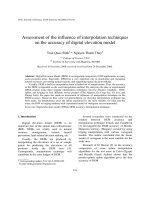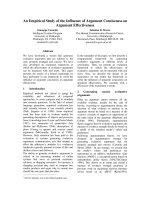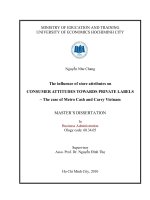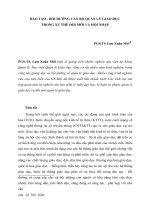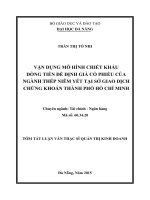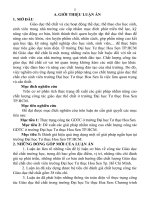The influence of brand equity on consumer responses toward Cho Gao dragon fruits brand - TRƯỜNG CÁN BỘ QUẢN LÝ GIÁO DỤC THÀNH PHỐ HỒ CHÍ MINH
Bạn đang xem bản rút gọn của tài liệu. Xem và tải ngay bản đầy đủ của tài liệu tại đây (842.22 KB, 7 trang )
<span class='text_page_counter'>(1)</span><div class='page_container' data-page=1>
The influence of brand equity on consumer responses toward Cho
Gao dragon fruits brand
Tran Tien Khoa1*<sub>, Nguyen Van Phuong</sub>1<sub>, Trinh Vu Anh Thi</sub>1<sub>, Nguyen Thi Minh Nguyet</sub>1<sub>, </sub>
Tran Van Dien1<sub>, Do Thi Sa Huynh</sub>1
1<sub>Center for Public Administration, International University </sub>
Vietnam National University - Ho Chi Minh City, Vietnam
*<sub>Corresponding author: </sub>
ARTICLE INFO ABSTRACT
DOI:10.46223/HCMCOUJS.
econ.en.10.1.217.2020
Received: September 16th<sub>, 2019 </sub>
Revised: November 25th<sub>, 2019 </sub>
Accepted: April 20th<sub>, 2020 </sub>
Keywords:
brand equity dimensions,
overall brand equity,
purchase intention, word of
mouth
This thesis study wants to implement a model test for better
understandings of brand equity and consumer responses toward
Cho Gao Dragon Fruit brand. With the rapid growth of agriculture,
including domestic consumption and export of the dragon fruits,
it is crucial to differentiate the Cho Gao Dragon Fruits to other
competitors in both domestic and foreign markets. Using
Structural equation modeling (SEM) to analyze the data of 274
questionnaires to investigate the effects of brand equity and its
dimensions on consumer responses. The results show that brand
equity dimensions such as brand awareness, brand association,
perceived quality are interrelated and those dimensions have a
direct and significant effect on brand equity, except brand
awareness. The results support the assumption that brand equity
has a positive relationship with consumer responses. The findings
shed light on the current issues of the market for dragon fruits,
which enables us to provide some suggestions for the Government
to facilitate farmers and traders in building brand names,
marketers for doing marketing activities, and students to know
about brand equity of agricultural product such as dragon fruits.
1. Introduction
</div>
<span class='text_page_counter'>(2)</span><div class='page_container' data-page=2>
to grow Dragon fruits directed cause damage to Vietnamese farmers. That leads to the emergence
of branding to compete in the diverse geographical market.
In Vietnam, two types of Dragon fruits are already named: Binh Thuan Dragon fruits and
Cho Gao Dragon fruits. Cho Gao Dragon fruits are famous for the red and thin cover compared to
Binh Thuan Dragon fruits. Consumers can hardly differentiate between two kinds of brands. In
fact, Cho Gao’ farmers are expanding the capacity of growing Dragon fruit in recent years. Those
events both are chances and challenges in competing in the domestic and foreign markets, so
assessing brand equity to build up the successful strategies for strong brand-building and
understandings of brand equity in different markets is needed, which will help our country protect
and enhance this valued asset.
Moreover, brand equity can influence consumer behavior (Hoeffler & Keller, 2003).
Indeed, previous research shows that brand equity has a positive relationship with consumer
responses (Cobb-Walgren, Ruble, & Donthu, 1995). Aaker (1996) claimed a brand was the only
way to remove oneself from commodity status price competition and in this case of commodity
good (dragon fruits). Meanwhile, there is a shortage of empirical research exploring the
relationships among brand equity dimensions and the impact of brand equity on the consumer
responses in Vietnam. Hence, we conduct this study to bridge this gap, also we would like to
contribute to the empirical literature of marketing for both marketers and students.
2. Literature review
2.1. Brand equity
Brand equity has been defined in many ways and many aspects since the 1980s. Simply,
brand equity can be defined as the power of the brand in consumers’ minds (Leone et al., 2006).
In the research of Yoo and Donthu (2001), brand equity is defined as the incremental utility or
value added to a product. Brand equity emerged as “a set of brand assets and liabilities linked to a
brand, its name, and symbol” (Aaker & Equity, 1991). These assets refer to brand awareness,
perceived quality, brand associations, brand loyalty, and other proprietary assets (Buil, Martínez,
& De Chernatony, 2013). Keller, Parameswaran, and Jacob (2011) defined brand equity based on
the perceptions of consumers, in terms of brand awareness, strength, preference, and brand
associations that consumers hold in their memory.
In practice, brand equity is considered as the brand description or brand strength that is
referred to as consumer-based brand equity which is different from the asset valuation definition
(Wood, 2000). No matter how brand equity is defined, a brand must be valued by consumers, and
the value of a brand reflects what consumers perceived (in five senses) and learned about the brand
as a result of their experience over the time (Keller, Parameswaran, & Jacob, 2011).
Following previous studies of Kim, Gon Kim, and An (2003); Pappu, Quester, and
Cooksey (2006); Yoo, Donthu, and Lee (2000), this study applies the consumer-based definition
of brand equity which is constructed by 4 dimensions: brand awareness, perceived quality, brand
associations, and brand loyalty.
</div>
<span class='text_page_counter'>(3)</span><div class='page_container' data-page=3>
2.2. Geographical brand
According to Docherty (2012), branding agricultural commodities: The development case
for adding value through branding the geographical brands use the “geographical indicator” for
branding tool that is considered as a representative of distinctiveness attributable to its origin in a
defined geographical area. To some extent, a geographical indicator is defined as “identifying a
good as originating in the territory of a Member, or a region or locality in that territory, where a
given quality, reputation or another characteristic of the good is, essentially, attributable to its
geographical origin”.
Cho Gao, a rural district of Tien Giang Province in the Mekong Delta region of Vietnam,
is the main supplier of Dragon fruits besides Binh Thuan Province, maintaining more than 3000
ha, supplying more than 50 000 tones for export and domestic consumption in 2013 (Tien Giang
Agricultural Office). Besides, Cho Gao is famous for Dragon fruits since the 20th<sub> century, with </sub>
features like heavy items, thin cover compared to other items of other suppliers.
2.3. Brand equity dimensions
The collective dimension of brand equity consists of four dimensions: brand awareness,
brand loyalty perceived quality, and brand loyalty, as proposed by Aaker (1996); Aaker and Equity
(1991); and Keller (1993). According to Strategic Brand Management of Keller et al. (2011), brand
awareness consists of brand recognition and brand recall and many researchers reveal that
consumer decision to purchase bases on the brand name, logo, packaging, and other visible
characteristics of the product for brand recognition. Perceived quality and brand associations are
also two key dimensions of brand equity (Buil, Martínez & De Chernatony, 2013). Keller et al.
(2011) claimed that strong brand association has a strong linkage to brand equity, in a simpler
explanation, the brand association is every single feature that links the brand with consumers’
memory (Aaker & Equity, 1991). The judgments of the consumer on a product’s overall excellence
or superiority are the perceived quality (Zeithaml, 1988). The research of Yoo and Donthu (2001)
defined brand loyalty as the tendency of a consumer to be loyal to a focal brand, which already
presented in the research of Oliver, Rust, and Varki (1997) by purchase intention at first in the
mind of consumers.
This research aims to investigate how consumer responses toward brand name Cho Gao
Dragon fruits. The significant aspects of brand awareness are the ability of consumers to recognize
and recall the performance of a brand. In the previous research of Pappu, Quester, and Cooksey
(2006) claimed the causal relationships among brand awareness, brand associations, perceived
quality, and brand loyalty. (Buil et al., 2013; Cobb-Walgren, Ruble, & Donthu, 1995; Keller et al.,
2011; Yoo et al., 2000) suggested a possible causal hierarchy among brand equity dimensions.
</div>
<span class='text_page_counter'>(4)</span><div class='page_container' data-page=4>
H1: Brand awareness has a positive influence on perceived quality.
H2: Brand awareness has a positive influence on the brand association.
Perceived quality and brand association was proposed to have an impact on customers’
loyalty to the brand (Keller et al., 2011). With the support of other research, proved the positive
relationship between perceived quality, brand association to brand loyalty (Keller et al., 2011).
Therefore, we propose the following hypotheses:
H3: Perceived quality has a positive influence on brand loyalty.
H4: the brand association has a positive relationship on brand loyalty.
Brand association, perceived quality, brand loyalty were theorized positive effects on
overall brand equity (Buil et al., 2013; Pappu et al., 2006). Previous research revealed that brand
association can make firms differentiate themselves from others and improve brand equity (Hal
Dean, 2004; Yoo et al., 2000). Higher perceived quality can offer the brands more competitive
advantages among a bundle of brands in the market (Kim, Gon Kim, & An, 2003; Yoo et al.,
2000). Brand loyalty can be counted as the main major contributes to brand equity, loyal
consumers can be another source of competitive advantage of the firm (Atilgan, Aksoy, & Akinci,
2005; Yoo et al., 2000). Hence, we propose the following hypotheses:
H5: Perceived quality has a positive influence on overall brand equity.
H6: Brand associations have a positive effect on overall brand equity.
H7: Brand loyalty has a positive influence on overall brand equity.
2.4. Word of Mouth (WOM)
Arndt (1967) claimed that WOM is the verbal communication between individuals about
a service or a good via various channels such as email, telephone, mailing list, and other means of
communication. In research of Bone (1995), WOM is created by conversations about product and
services between who are not stake-holders of the company with a medium perceived of the
producer. Higie, Feick, and Price (1987) also revealed in his research that conversation motivated
by salient experience plays an important role in information diffusion.
Among the existing channel marketing for Dragon fruits in Vietnam, WOM is an easy and
effective way to communicate with target consumers. Furthermore, in the research of Brown,
Kozinets, and Sherry Jr (2003), and Katz, Lazarsfeld, and Roper (2017), WOM as a source of
information has a significant influence on consumers’ decisions than other marketing
communication channels.
2.5. Consumer responses
</div>
<span class='text_page_counter'>(5)</span><div class='page_container' data-page=5>
their minds are the disadvantages of the products and people are likely to tell other people about
these things (Roster & Richins, 2009). Considering how influential WOM would be to shape the
perceptions of the customers, WOM should be another element of consumer response in this
research.
Buil et al. (2013) developed the research that counted the influence of brand equity on
consumer responses in the UK and Spain in terms of four brand equity dimensions and empirically
tested the relationship between overall brand equity toward consumers’ responses. As a result,
there is a strong relationship between brand equity and three dimensions of consumers’ responses:
willingness to buy price premium, brand preference, and purchase intention, the pessimistic result
in brand extension. This research arm to test a specific brand that branding base on geographical,
there is no reason for testing brand extension.
The willingness to buy a price premium is the number of money consumers who are willing
to buy a product of a brand compared to other products of other brands with the same features or
benefits (Keller et al., 2011). Brand equity influences consumer willingness to buy a product with
a price premium, making price less of a consideration when purchasing a product (Keller &
Lehmann, 2003; Keller et al., 2011).
Brand preference was defined as the positive evaluations, preferences of a favorable brand
compared to other brands (Keller et al., 2011), furthermore, research of Cobb-Walgren et al. (1995)
showed that the higher brand equity the greater brand preferences, and higher tendencies to buying
a product.
The relationship between brand preference and purchase intention was confirmed by the
research of Buil et al. (2013) as well as in other research of Hellier, Geursen, Carr, and Rickard (
2003), theorized by Ajzen and Fishbein (1977).
Several researchers have studied how WOM influences on the decision to purchase
products among brands (Chevalier & Mayzlin, 2006; Godes & Mayzlin, 2009; Grewal, Cline, &
Davies, 2003; Herr, Kardes, & Kim, 1991). There was remarkable literature discussing the impact
of WOM on how consumers make their decision (Chen, Wang, & Xie, 2011; Gupta & Harris,
2010; Herr, Feick, & Price, 1991), especially for new products (Peres, Muller, & Mahajan, 2010).
Therefore, we propose the following hypotheses:
H8: Overall brand equity has positive influences on consumers’ willingness to buy price
premiums.
H9: Overall brand equity has a positive influence on consumers’ brand preferences.
H10: Overall brand equity has a positive influence on consumer’s purchase intention.
H11: Overall brand equity has a positive influence on consumer’s WOM (Word of Mouth).
H12: Brand reference has a positive influence on consumer’s purchase intention.
H13: Word of mouth (WOM) has a positive influence on consumer purchase intention.
In the study of Roberts, Morrison, Chandrashekaran, and Gordon (2004), he argued that
WOM is encouraged by the preference for brands. According to (Hutter, Hautz, Dennhardt, &
Füller, 2013), there was a significant influence of brand awareness on word of mouth. Therefore,
we propose the following hypothesis:
</div>
<span class='text_page_counter'>(6)</span><div class='page_container' data-page=6>
3. Methodology
In this study, we applied the back-translation procedure of Brislin, Lonner, and Thorndike
(1973) to ensure the English and Vietnamese versions of questionnaires have equivalent meanings.
We converted the English questionnaire into Vietnamese and then translated it back into English.
This approach allows us to eliminate the potential discrepancies by comparing the second English
version to the original one to ensure the consistency in meaning. All measurement items were
evaluated on a 5-point Likert scale ranging from 1 (strongly disagree) to 5 (strongly agree).
3.1. Measurement scales
All the measurement scales were constructed based on previous literature. The list of all
36 items used to measure 9 latent variables in the study is presented in the following table:
Table 1
Measurement scales
Construct Measurement
Brand awareness
(Yoo et al., 2000)
AW1. I am aware of brand X
AW2. When I think of X, brand X is one of the brands that come to my mind
AW3. X is a brand of Dragon fruits I am very familiar with
AW4. I Know brand X look like
AW5. I can recognize brand X among other competing brands of Dragon
fruits
Perceive quality
(Pappu et al.,
2006)
PQ1. Brand X offers very good quality products
PQ2. Brand X offers products of consistent quality
PQ3. Brand X offers very reliable products
PQ4. Brand X offers the product with excellent feature
Brand associations
(Aaker, 1996;
Pappu et al., 2006)
AS1. Brand X is a good value for money
AS2. Among Dragon fruits brands, I consider brand X a good buy
AS3. Considering what I pay for a brand X, I would get much more than my
money’s worth
AS4. I trust the place which makes brand X
AS5. I like the place which makes brand X
AS6. The place which makes brand X is credibility
Brand Loyalty
(Yoo et al., 2000)
LO1. I consider myself to be loyal to brand X
LO2. Brand X would be my first choice when considering buying Dragon fruits
LO3. I will not buy other brands of Dragon Fruit if brand X is available in store
Overall brand
equity
(Yoo et al., 2000)
OBE1. Even if another Dragon fruits brand has the same features as brand
X, I still choose X
</div>
<span class='text_page_counter'>(7)</span><div class='page_container' data-page=7>
Construct Measurement
Consumer
willingness to pay
a price premium
Netemeyer et al.
(2004)
PR1. The price of brand X would have to go up quite a bit before I would
not consider buying it
PR2. I am willing to pay a higher price for brand X (Dragon fruits) than for
other brands of Dragon fruits
PR3. I am willing to pay a lot more for brand X (Cho Gao Dragon fruits)
than for other brands of Dragon fruits
Brand reference
Sirgy et al. (1997)
PRE1. I like brand X better than other brands of Dragon fruits
PRE2. I would use brand X more than other brands of Dragon fruits
PRE3. Among brands of Dragon fruits, brand X is my preferred brand when
I choose to buy
Purchase intention
Erdem, Swait, and
Valenzuela (2006)
PI1. I would buy brand X (Cho Gao Dragon fruits) because I know it well
PI2. I would seriously consider buying brand X (Cho Gao Dragon fruits)
because I know about Dragon fruits
PI3. It is very likely that I would buy brand X (Cho Gao Dragon fruits)
because I know it well
PI4. Next time if I have demand for Dragon fruits, I would buy brand X
Word-of-mouth
Goyette, Ricard,
Bergeron, and
Marticotte (2010)
WOM1. I mostly say positive things to others.
WOM2. I am proud to say to others that I am Brand X (Cho Gao Dragon
fruits)’s, customer
WOM3. I strongly recommend people buy products of Brand X (Cho Gao
Dragon fruits)
WOM4. I spoke of Brand X (Cho Gao Dragon fruits) much more frequently
than about any other
WOM5. I would give a recommendation about Brand X for acquaintances
when they need Dragon Fruit
Note Brand X is Cho Gao Dragon fruits
Source: The research’s data analysis
3.2. Data collection
3.2.1. Research design
The survey questionnaires are distributed to gain the perceptions of consumers about brand
equity dimensions, overall brand equity, and consumer responses toward Cho Gao Dragon fruits
brand. The data was collected through surveys at several locations in Ho Chi Minh City, Tien
Giang province, and Long An province.
</div>
<!--links-->


